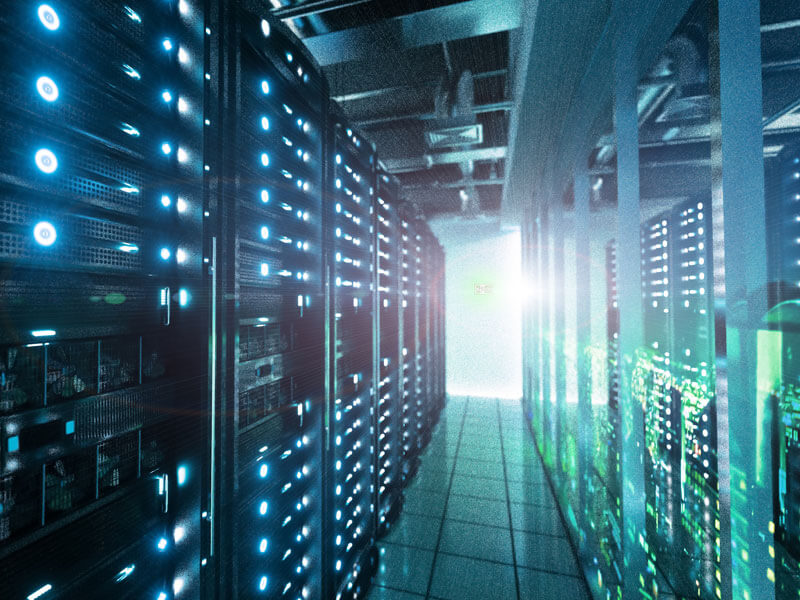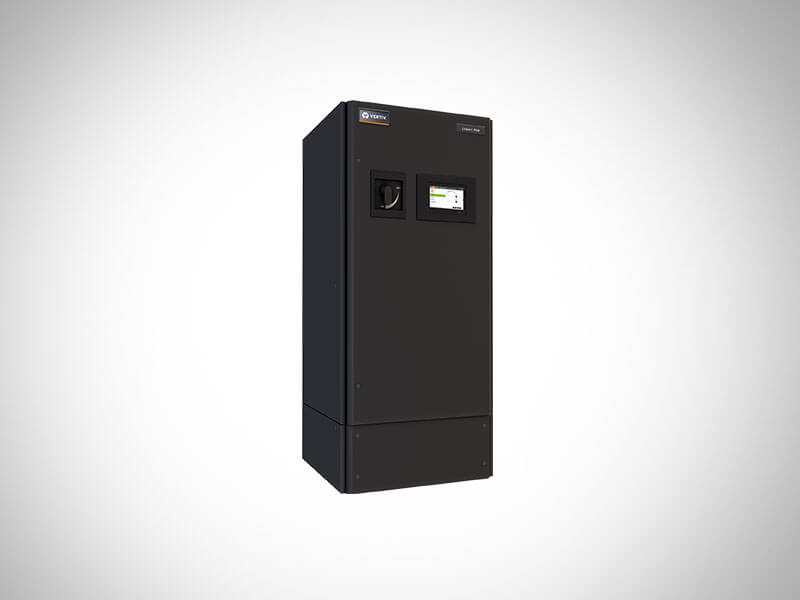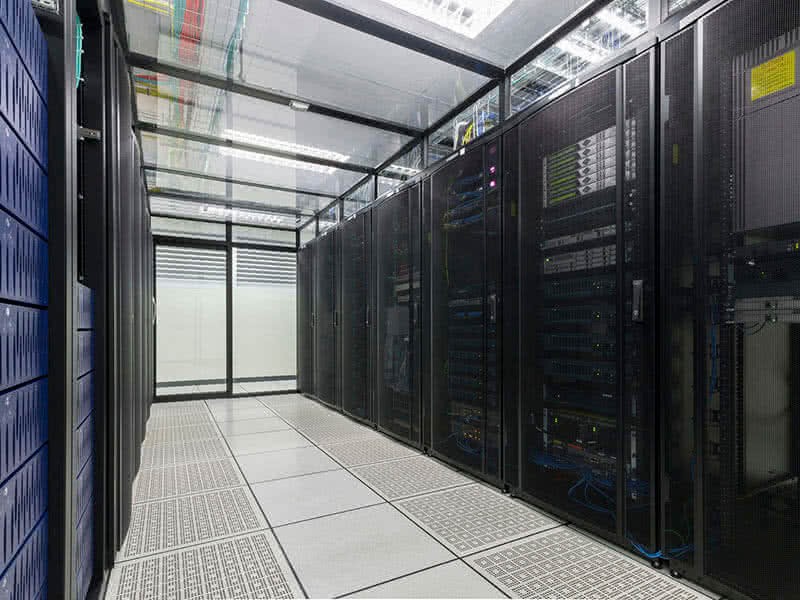With 1 in 8 outages caused by cooling failures, can operators rely on systems built for comfort, not IT?
Server rooms and IT closets continuously generate heat. Yet many operators still rely on standard comfort cooling systems designed for human-occupied spaces for server room cooling. While these systems may appear adequate, they aren’t built to manage the continuous, high-density heat loads produced by IT gear running 24x7x365. This often leads to overheating. Comfort cooling is meant for seasonal use and fluctuating demand, not the round-the-clock requirements of critical IT spaces. Over time, that mismatch can cause equipment stress, higher costs, and downtime. According to Uptime Institute’s Annual Outage Analysis 2025, cooling-related failures account for roughly one in eight impactful outages annually and may shift in the coming years.
In modern data centers and IT environments, optimal heat removal is mission-critical, not only for equipment efficiency and longevity but also to maintain uninterrupted room availability where downtime is not an option. Dedicated IT cooling systems provide airflow that matches IT equipment needs and advanced controls for sensitive equipment. These units offer 24/7/365 reliability and redundancy, maintaining continuous operation and protecting critical infrastructure.
Why comfort cooling fails in critical IT environments
Insufficient airflow volume causes hotspots
Standard comfort cooling systems deliver only ~100 cubic feet per minute per kilowatt (CFM/kW) of airflow, a design optimized for human comfort and quiet operation that falls below the 150 CFM/kW servers require (see Figure 1). The resulting airflow deficit strains IT equipment, leading to serious operational consequences:
- Hot air recirculation: Insufficient cold airflow (~100 CFM/kW) causes servers to pull hot exhaust air back into intakes, raising temperatures by 5–15°F and creating hazardous hotspots.
- Increased server fan activity: Internal server fans work harder to mitigate the heat. This increases component straining, power consumption, and disruptive noise levels
- Emergency shutdown risks: Servers automatically power off when overheating exceeds safe limits, causing unplanned downtime.
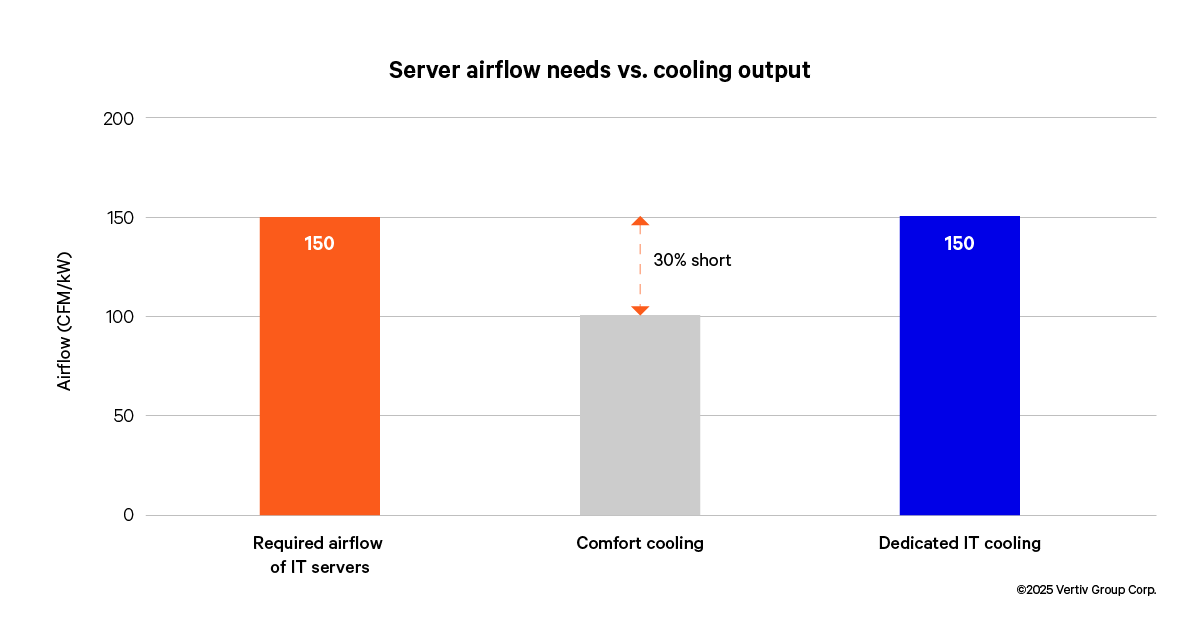
How dedicated cooling optimizes airflow
Dedicated IT cooling systems are engineered for targeted, high-volume airflow tailored to server environments. These solutions typically include:
- Advanced sensors to dynamically adjust cooling output based on real-time IT heat loads.
- Airflow containment strategies, such as hot aisle/cold aisle in data centers, prevent recirculation and improve cooling focus.
- High-performance fans and airflow controls that deliver sufficient cool air to server inlets.
- Scalable architectures that adjust to increased rack densities and evolving thermal loads.
- Higher airflow capacity, maintaining stable, consistent temperatures across all racks to reduce thermal stress and avoid inefficiencies.
As demonstrated in Figure 2 below, in the comfort cooling scenario (left), operating at 100 CFM/kW, insufficient airflow from the cooling unit causes hot air to recirculate from the rear of the rack to the front. This recirculation leads to uneven cooling, with servers at the top of the rack at risk of overheating and potential shutdown. In contrast, dedicated IT cooling systems (right), operating at 150 CFM/kW, allow proper airflow distribution across the entire rack height. This provides consistent and optimal operating conditions for all IT servers, preventing thermal stress and maintaining reliable performance.
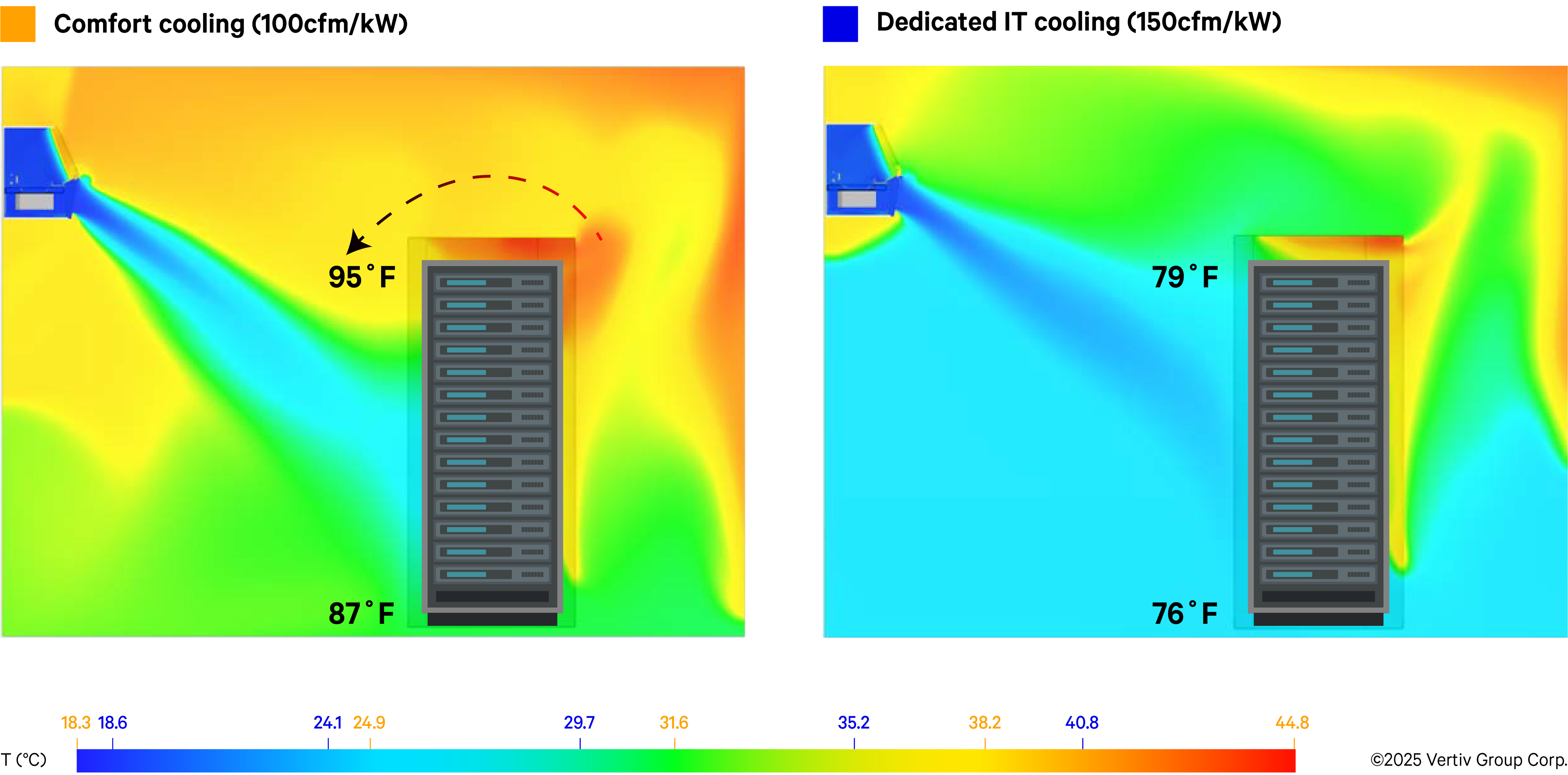
Comfort cooling units consume more energy
Cooling units have two capacities: sensible cooling, which lowers air temperature, and latent cooling, which removes humidity. IT equipment produces only sensible heat, which means only sensible cooling capacity contributes to actual heat removal.
Comfort cooling units, however, are designed for environments with both temperature and humidity control needs. As a result, 30–40% of their capacity is allocated to latent cooling or dehumidification that servers don’t require. This means only 60–70% of a comfort unit’s output directly supports IT cooling. For example (see Figure 3), a sensible heat ratio (SHR) of 0.70 means that only 70% of the comfort cooling system changes the temperature. To compensate, facility teams must install oversized systems to deliver the necessary sensible capacity.
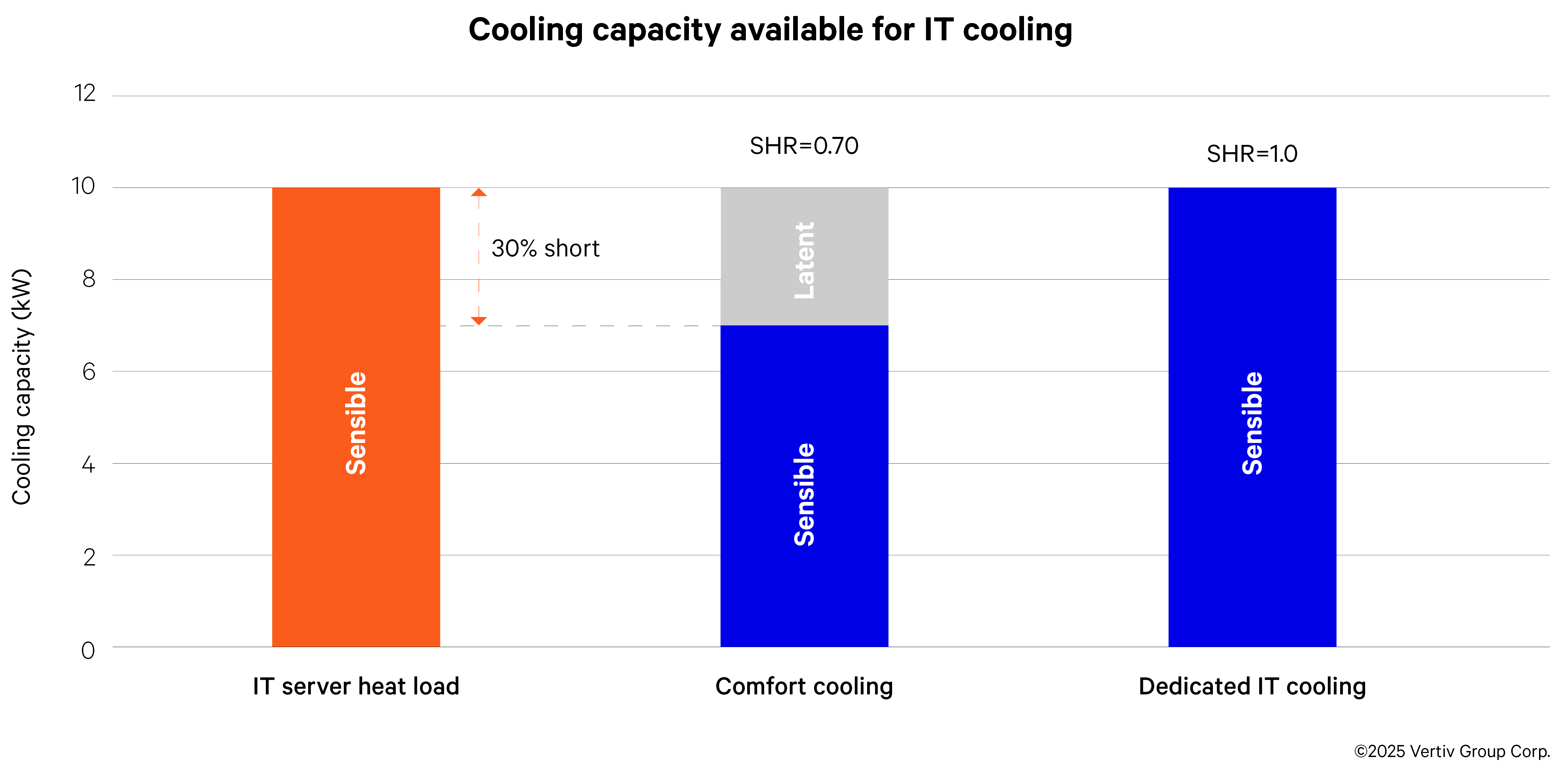
Cooling unit oversizing comes at a cost: comfort cooling units can consume up to 35% more energy to provide the same level of adequate cooling. In server rooms with constant, high thermal loads, this misalignment drives long-term energy waste, inflated operational costs, and fundamentally poor efficiency.
The advantage of dedicated IT cooling
Dedicated IT cooling systems are designed specifically for IT environments. They focus nearly 90–100% of their output on sensible cooling. This eliminates oversizing and enables power to be used efficiently, not lost on dehumidification. By matching capacity directly to the actual cooling demand, dedicated IT cooling systems deliver stable, targeted performance without the energy penalty of comfort systems.
Comfort cooling systems can fail under continuous demand
Comfort cooling systems are designed for intermittent operation and are typically aligned with occupancy patterns or seasonal needs. These units are expected to shut down during off-hours or cooler months in commercial and residential settings (see Figure 4). IT rooms operate under a very different load profile—continuous, year-round heat generation with zero tolerance for cooling gaps.
Under these conditions, comfort cooling systems can struggle to operate for the continuous 24/7/365 IT cooling needs. When forced to run in extreme ambient conditions, their components, especially compressors, may have difficulty operating properly, leading to higher failure rates and more frequent maintenance. These systems are also not built to handle low ambient startup or extreme temperature fluctuations, which can cause operational failures. The consequences are severe:
- Unexpected shutdowns during nights or weekends can lead to catastrophic overheating.
- Compressor fatigue from frequent cycling increases the risk of failure and emergency repairs
- Maintenance intervals shorten, raising long-term operational costs and compromising availability.
How dedicated IT Cooling delivers continuous operation
Dedicated IT cooling systems are built for mission-critical applications and operate reliably 24/7/365. They:
- Use industrial-grade variable-capacity compressors and fans that deliver variable airflow to match server requirements precisely. Unlike basic three-speed fans in comfort systems, these fans provide continuous, demand-based airflow control for higher efficiency and reliability
- Include redundancy features or N+1 configurations to maintain cooling in case of unit failure.
- Reduced maintenance frequency due to resilient, high-duty-cycle component design, minimizing operational disruptions.
- Reliable operation in various conditions, with configurations rated for -31°F to maintain year-round startup and consistent cooling, even in extreme climates.

Lack of control features increases cooling failure risks
Comfort cooling systems vary widely, from mini splits with built-in controls to larger units that often require custom configuration. In more complex setups, reliability depends heavily on how well all components work together. Many comfort cooling units do not include built-in redundancy, which can be important for maintaining reliable server room cooling. If the unit fails, there's usually no immediate backup, increasing the risk of thermal shutdowns. In small server rooms or network closets, relying on comfort cooling often results in the following:
- Complete cooling loss because standard units don't include failover protection.
- Limited support for lead-lag or standby configurations complicates redundancy planning.
- Delayed incident response due to limited alarm capabilities in some units, especially failures occurring after business hours.
- Lack of real-time alerts means issues may go unnoticed until damage is done.
How dedicated IT cooling provides failover protection
Dedicated IT cooling systems are engineered with redundancy and reliability in mind. Features often include:
- N+1 configurations, where one or more units are on standby to take over if a primary unit fails. Control systems manage unit sequencing automatically.
- Units' rotation, standby modes, and cascading operation balance workload and minimize wear, enabling continuous system performance.
- Factory-installed control and monitoring, designed for the specific demands of IT infrastructure.
- Intelligent monitoring with multiple alarm points sends real-time alerts, allowing technicians to respond quickly and reduce downtime.
Elevating server room cooling from risk to resilience
Relying on comfort cooling systems can lead to higher costs over time, despite lower upfront expenses. What may seem like savings initially can result in premature hardware wear, unplanned repairs, increased energy use, and avoidable downtime. The technical divide is undeniable: office-grade systems cannot deliver the temperature control and continuous reliability that sensitive IT equipment demands.
Dedicated IT cooling technology offers a more reliable solution for server environments. Unlike comfort cooling units, dedicated IT cooling adapts to specific heat loads and helps protect your investment in critical infrastructure. As technology advances and server demands grow, choosing the right cooling approach becomes essential for maintaining operational success.
Your servers work around the clock. Shouldn't their cooling system do the same?
Deploy dedicated IT cooling for your server room
Upgrade to dedicated cooling for increased IT infrastructure protection. Gain greater reliability, minimize downtime, and optimize performance with solutions customized to your IT needs. Contact Vertiv today.


